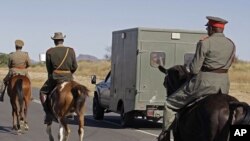Germany has returned to Namibia 20 skulls that were taken for so-called scientific tests when Germany ruled the southern African country more than a century ago.
Thousands of Namibia's ethnic Hereros and Namas welcomed home the skulls at an airport Tuesday in the capital, Windhoek.
Many people in the crowd wore ethnic clothing, and cheered as the skulls were lowered in caskets onto the tarmac. Some people waved banners and called for reparations.
Beginning in 1904, the Herero and Nama people resisted German attempts to take over their land and were killed by the thousands. Others died in concentration camps. The remains of some were sent to Germany for experiments.
Historians say the experiments were meant to show the supposed racial superiority of white Europeans over black Africans.
About 80,000 Hereros lived in Namibia when the uprising began, but only 15,000 were left after the slaughter. Many of the Nama people also died.
Namibian President Nahas Angula told the crowd Tuesday that the remains "are testimony to the horrors of colonialism and Germany's cruelty" against the Namibian people. He said Namibians accept the remains as a "symbolic closure of a tragic chapter."
Germany ruled Namibia, which was then called South West Africa, from 1884 to 1915.
Some information for this report was provided by AP, AFP and Reuters.





